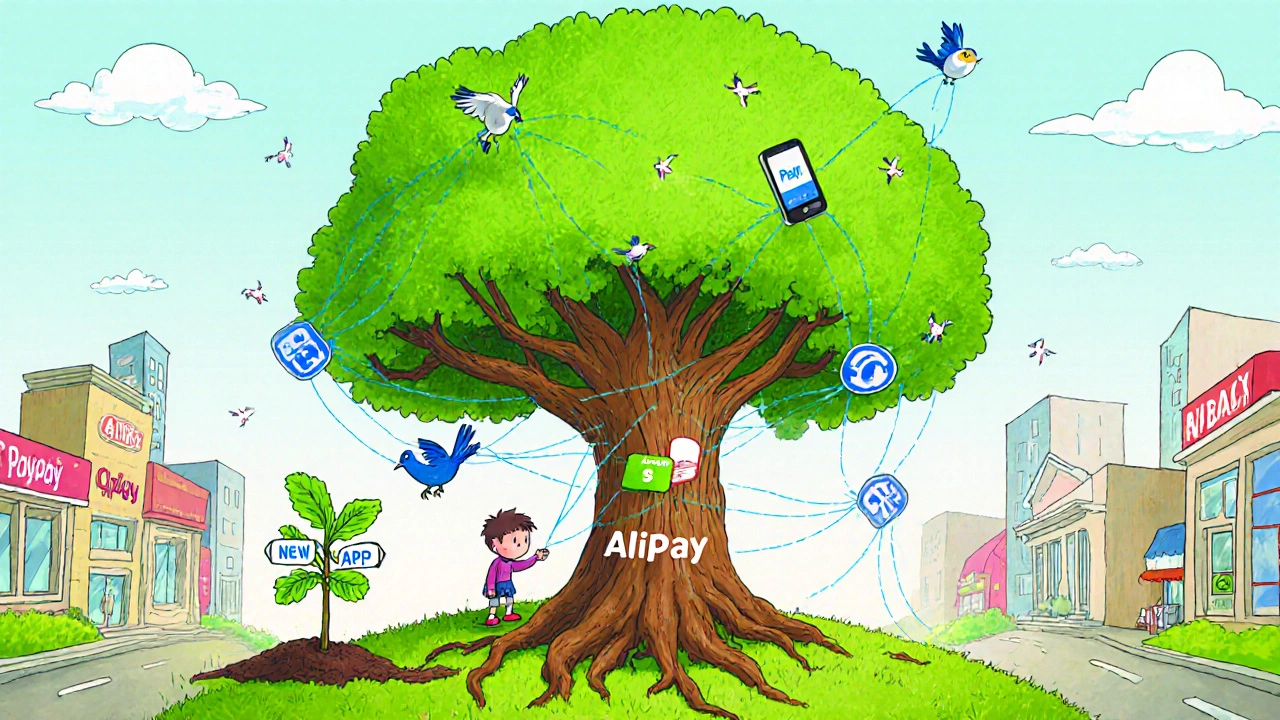Fintech Moat Assessment Tool
Data Moat Assessment
Distribution Moat Assessment
Regulatory Moat Assessment
Why Most Fintech Startups Fail - And Why a Few Dominate
There are thousands of fintech companies out there. Apps that let you send money, invest spare change, or get loans in minutes. But only a handful are truly thriving - not just surviving, but growing profitably, year after year. Why? Because they’ve built something no one else can easily copy. That something is called a fintech moat.
Think of a moat like the ditch around a medieval castle. It’s not just a barrier. It’s a system that makes it expensive, slow, and often impossible for anyone else to get in. In fintech, these moats aren’t made of water and stone. They’re made of data, distribution networks, and regulatory expertise. And the companies that master all three? They don’t just win. They own the game.
Data Moats: The More You Use It, The Harder It Is to Beat
Not all data is created equal. A fintech app that collects your spending habits is useful. But a company that processes $14.9 trillion in payments across 200 countries over 15 years? That’s a fortress.
Visa doesn’t just process payments. It learns from every single one. Every declined transaction, every fraud attempt, every merchant’s seasonal spikes - it all feeds into smarter algorithms. The more transactions it handles, the better its fraud detection gets. JPMorgan spent $450 million building its fraud system because it needed to analyze over a billion transactions annually just to hit 99.9% accuracy. New entrants can’t afford that. They can’t even get close.
This isn’t just about volume. It’s about network effects. The more merchants accept Visa, the more consumers want it. The more consumers use it, the more merchants have to accept it. It’s a loop that gets stronger every day. A new payment app might offer lower fees, but if 9 out of 10 stores won’t take it, who cares? That’s the power of a data moat - it doesn’t just protect you. It grows with you.
Distribution Moats: Who You Know Matters More Than What You Build
Building a better app doesn’t mean anything if no one can use it. That’s why distribution moats are just as important as data. It’s not about having the prettiest interface. It’s about being everywhere.
PayPal didn’t win because it was the first digital wallet. It won because it became the default payment method on eBay. Then it got embedded in Shopify stores. Then it partnered with banks. Today, it connects 426 million users with 34 million merchants. That’s not luck. That’s strategy. Each new user makes the network more valuable to everyone else. That’s a classic network effect - and it’s nearly impossible to replicate.
Ant Group’s Alipay is another example. It didn’t just build a payment app. It tied itself to Alibaba’s entire e-commerce empire. If you shop on Taobao or Tmall, you use Alipay. No choice. No switching. That’s distribution at scale. And it’s why Alipay processed $13.1 trillion in payments in 2023 - more than most countries’ GDPs.
Companies with strong distribution moats don’t just acquire customers. They make customers irrelevant to competitors. Why would a merchant switch from PayPal to a new service if it means losing access to 426 million buyers? The cost of switching isn’t just technical. It’s lost revenue.

Regulatory Moats: The Hidden Advantage No One Talks About
Most people think fintech is about tech. But the real edge? Knowing how to play by the rules - and making sure the rules work in your favor.
Getting a banking license in one country is hard. Getting 56 licenses across 46 countries? That’s what Stripe did over 12 years. It didn’t just hire lawyers. It built entire compliance teams, mapped every local regulation, and paid millions in fees. The result? A moat that’s almost impossible to cross.
Block (formerly Square) spent $187 million on compliance in 2023. That’s 14.3% of its operating expenses. Most startups can’t afford that. And even if they could, they wouldn’t have the relationships. Regulators don’t trust new players. They trust the ones who’ve been there, paid their dues, and proved they won’t break the system.
Deloitte found that established fintechs spend 22-35% less per transaction on compliance than newcomers. Why? Because they’ve already done the work. They’ve got templates, contacts, and a track record. For a new company, getting licensed in the EU under DORA could cost half a million dollars. That’s not a cost of doing business. It’s a wall.
The Real Secret: It’s Not One Moat. It’s All Three Together
The biggest fintech winners don’t rely on just one advantage. They stack them.
Visa has data (trillions in transactions), distribution (accepted everywhere), and regulation (licenses in 200+ countries). That’s why it’s still dominant after 60 years. Stripe? Same story. Data from millions of payments. Distribution through 2,300 financial institutions. And 56 licenses keeping it legal everywhere it operates.
Companies that only have one moat? They get eaten alive. A fintech with great data but no distribution? Merchants won’t accept it. One with distribution but no fraud detection? Customers get hacked. One with licenses but no users? It’s just paperwork.
According to Gartner, companies using all three moats see 63% higher customer retention. One bank client cut payment processing costs by 47% after switching to a platform with strong data, distribution, and regulatory backing. That’s not a nice-to-have. That’s survival.

What Happens When Moats Break - And How to Keep Them Strong
Moats aren’t permanent. They can erode. Clubhouse was huge in 2020. But its tech was easy to copy. Within months, Twitter, Discord, and Instagram launched similar features. Clubhouse had no moat - just hype.
Even giants aren’t safe. Apple’s ecosystem is legendary - but when regulators forced it to open up its App Store, its moat got a crack. Fintechs with closed systems face the same risk. Regulations change. New tech emerges. AI tools can now generate fraud patterns faster than ever.
The key? Constant reinforcement. Visa doesn’t rest. It’s investing in AI-powered fraud detection. Stripe keeps adding licenses. PayPal is embedding payments into new platforms like TikTok Shop. The moat isn’t a wall. It’s a living system that needs upkeep.
CB Insights predicts that by 2027, 70% of surviving fintechs will have at least two of these three moats. The ones with only one? They’ll be bought, merged, or shut down.
How to Spot a Real Fintech Moat - Before You Invest or Partner
If you’re evaluating a fintech company - whether to invest, work for, or partner with - ask these three questions:
- Does it have unique, hard-to-copy data? Look for transaction volume, fraud detection accuracy, or user behavior patterns that took years to build. If they can’t show you numbers like ‘1.2B transactions analyzed’ or ‘99.9% fraud detection rate,’ it’s not a real data moat.
- Is it embedded in places people already use? Is it on Shopify? In Walmart’s app? On eBay? If it’s only on its own website, it’s not a distribution moat. Real distribution means being where the customers already are.
- How many licenses does it hold? Ask for the list. If it’s only licensed in one country, it’s not global. If it has 20+ licenses, it’s likely spent $100M+ on compliance. That’s a sign of serious moat-building.
Also check financials. Companies with real moats show: stable or growing free cash flow, high gross margins (70%+), and low customer acquisition costs over time. If revenue is rising but profits are flat or falling? They’re probably burning cash to fight for market share - not building a moat.
Final Thought: Moats Are About Long-Term Power, Not Quick Wins
Fintech moves fast. But the winners aren’t the ones who launch the flashiest app. They’re the ones who spent five years building something no one else can copy.
Data, distribution, regulation - these aren’t buzzwords. They’re the three pillars of real, lasting power in fintech. And if you’re trying to build a company in this space, you need at least two of them. Otherwise, you’re not building a business. You’re building a target.
What exactly is a fintech moat?
A fintech moat is a sustainable competitive advantage that protects a company from competitors. It’s not a single feature or app - it’s a system of barriers like proprietary data, widespread distribution networks, and deep regulatory expertise that make it extremely hard for others to enter or replicate the business. Think of it like a castle’s moat: it doesn’t guarantee victory, but it makes attacking the castle far too costly for most.
Can a fintech company have just one type of moat and still succeed?
It’s possible, but risky. A company with only a data moat - like a smart budgeting app - might grow quickly but will struggle to scale without distribution. One with only distribution - like a payment tool accepted at a few big retailers - won’t survive if fraud rates spike. The strongest companies combine at least two, and ideally all three. Data without distribution is invisible. Distribution without regulation is fragile. Regulation without data is expensive. Together, they’re unstoppable.
How long does it take to build a fintech moat?
It takes years - usually 5 to 10. Data moats need 3-5 years of transaction volume to become useful. Distribution moats require 5-7 years to embed into major platforms. Regulatory moats take the longest: 5-7 years just to get licenses in key markets. Stripe spent 12 years to get 56 licenses. Ant Group spent 7 years to integrate with Alibaba’s ecosystem. There are no shortcuts. Moats are built slowly, deliberately, and with massive investment.
Are regulatory moats always good for consumers?
Not always. Regulatory moats protect companies from competition, which can lead to higher prices and less innovation. But they also protect consumers - by ensuring companies follow anti-fraud, anti-money laundering, and data privacy rules. The best regulatory moats strike a balance: they’re not about hiding from oversight. They’re about proving you can handle it better than anyone else. That’s why users trust Stripe and PayPal with their money - they know compliance means security.
What’s the biggest mistake fintech founders make when trying to build a moat?
They focus on product features instead of systems. They build a slick app, get 100,000 users, and think they’ve won. But moats aren’t built with UI/UX. They’re built with scale, repetition, and time. Founders who chase viral growth without planning for data accumulation, merchant partnerships, or compliance are building sandcastles. When the tide comes in - whether it’s a new regulation, a better competitor, or a data breach - their company washes away.




This is so true. I saw a fintech startup in Bangalore try to compete with UPI-based apps-no licenses, no data scale, just a pretty UI. They shut down in 8 months. Real moats aren’t sexy, but they’re the only thing that lasts. 🤝
The real insight here is the emergent property of stacked moats-data + distribution + regulation isn’t additive, it’s multiplicative. You’re not just creating barriers; you’re inducing path dependency. The network effects compound non-linearly because each moat reduces the entropy of user acquisition, operational risk, and regulatory arbitrage. Stripe’s 56 licenses? That’s not compliance-it’s institutional capture. Once you’ve embedded yourself into the regulatory substrate, you become the de facto standard. New entrants aren’t just outspent-they’re out-structured. And that’s why VC-funded ‘innovation’ in fintech is mostly just regulatory arbitrage with a React frontend.
Ugh, another ‘moat’ article. Like, wow, big brain move-companies that spend 10 years and $200M on bureaucracy and data hoarding ‘win.’ Groundbreaking. Meanwhile, real innovation happens in the cracks where regulators aren’t looking. But sure, let’s all bow to the Visa oligarchy because they’ve got ‘trillions in transactions.’ Congrats, you built a digital toll road and called it ‘security.’ The only thing more boring than this post is the fact that 90% of fintech unicorns are just rebranded banks with better UX. Next up: ‘Why Airplanes Have Wings: The Unbeatable Advantage of Aerodynamic Lift.’